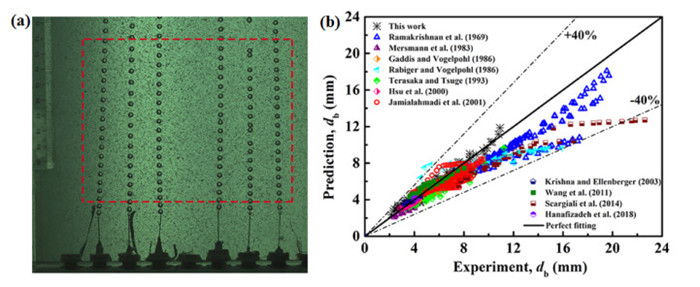Scientist Proposed Accurate Prediction Model of Bubble Diameter for Industrial Gas Sparger
Gas-liquid and gas-liquid-solid reactors have been widely applied in fermentation, photosynthetic culture, metallurgy, and many other processes in chemical industries. Bubble size is one of the most important parameters for accurate design of gas-liquid apparatus. Accurate prediction of bubble diameter is crucial for proper design, optimization, and scale-up of gas-liquid apparatuses. Most previous researches only focused on the orifice superficial gas velocity below 10 m/s, which was too low for industrial gas-liquid reactors.
Recently, the research team led by Prof. YANG Chao from Qingdao Institute of Bioenergy and Bioprocess Technology (QIBEBT), Chinese Academy of Sciences (CAS), have systematically investigated the influences of orifice diameter, liquid viscosity, surface tension force, and orifice superficial gas velocity on bubble diameter of gas sparger under industrial jetting conditions.
In this research, the bubble diameter was investigated in a rectangular vessel made of transparent Plexiglas. Bubbles were recorded by taking pictures with a single-lens reflex camera, and a typical bubble formation image is illustrated in Fig.1 (a). Bubble sizes were analyzed and calculated using patented software (Chinese Software Copyright Registration Number: 2017SR354522).
Based on the extensive experimental results, a simple correlation for predicting the bubble diameter is proposed using nonlinear least square optimization. The new correlation was successfully validated by comparing prediction results with the experimental data over a wide range of operating conditions and working systems from the literature. The comparison of the predicted results by the new model versus the experimental data from our work and literature is demonstrated in Fig.1 (b). Only 6.54% of the 657 experimental results obtained from literature have the deviations of more than 30%, indicating the proposed correlation in this work can be applied extensively with reasonable accuracy.

Fig.1 (a) Typical bubble formation image; (b) Rational validation of the proposed prediction correlation. (Image by HUANG Qingshan)
The related findings were published in Chemical Engineering Science. This work was supported by the National Natural Science Foundation of China (Nos. 21878318; 21808234; 91434114), the Instrument Developing Project of the CAS (YZ201641), and “Transformational Technologies for Clean Energy and Demonstration”, Strategic Priority Research Program of the CAS (XDA21060400).
(Text by GENG Shujun)
Contact:
CHENG Jing
Qingdao Institute of Bioenergy and Bioprocess Technology, Chinese Academy of Sciences
Tel: 86-532-80662647
E-mail: chengjing@qibebt.ac.cn